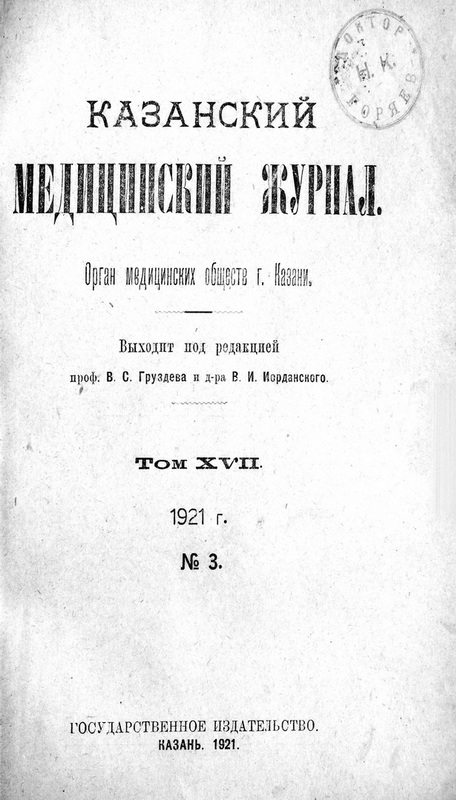Том 17, № 3 (1921)
- Год: 1921
- Выпуск опубликован: 13.09.1921
- Статей: 14
- URL: https://kazanmedjournal.ru/kazanmedj/issue/view/4179
Весь выпуск
К 25-летию открытия Röntgen’a
Аннотация
В сегодняшнем годичном заседании нашего Общества на меня возложена лестная задача отметить 25-летний юбилей величайшего и столь благодетельного по своим последствиям открытия Вюрцбургским профессором физики Wilhelmʹом Коnrаdʹом Röntgen’oм неведомых дотоле лучей— х-лучей, которым мы, благодарные памяти ученого, присвоили название „рентгеновских лучей“.
 271-290
271-290


О нервных клетках Аuerbach’oвa и Меissner’ова сплетения толстых кишок
Аннотация
В 1914 году мною было предпринято исследование иннервации прямой кишки млекопитающих. По независящим от меня обстоятельствам работа эта до сего времени не может считаться законченной, и лишь часть результатов; имеющих самостоятельный интерес, является предметом настоящего сообщения.
 291-309
291-309


К учению о функциональной диагностике нефритов
Аннотация
Если я в течении 15-летней профессорской деятельности ни разу не решила преподнести своим слушателям курс патологии почек, то это с первого взгляда Вам покажется чем-то удивительным. У Вас появится невольно вопрос—почему же? Не потому— отвечу я,—чтобы этот отдел частной патологии был для меня неинтересен и не потому, чтобы я не знал его, но потому, что преподавание его в том виде, как это требуется в программе, и как он излагается в рекомендованных де я преподавания руководствах, не удовлетворяло меня и по своему направлению, и, главное, по своей тенденциозности.
 310-338
310-338


К вопросу о картине крови при скрытой малярии
Аннотация
В малярийных местностях, наряду с явными проявлениями малярийных заболеваний, встречается, как известно, значительное число случаев скрытой малярии, т. е. таких форм последней, когда нет на лицо ни определенной клинической картины, ни плазмодиев в периферической крови.
 339-351
339-351


 352-358
352-358


Случай острой желтой атрофии печени
Аннотация
Хотя в литературе от времени до времени описываются случаи острой желтой атрофии печени, все же заболевание это—настолько редкое, этиология его до сих пор еще настолько темна, что каждый такой Случай заслуживает того, чтобы остановить на нем свое внимание.
 359-369
359-369


К вопросу об отношении между noma и angina. Vincenti
Аннотация
Заболевания помой, в общем очень редкие, иногда,—как то, например, бывало, по сообщению Вeitzk e, во Франции,—учащались до размеров маленьких эпидемий. Нечто подобное в настоящее время, как будто, наблюдается и у нас, а потому мой доклад имеет свой raison d’etre в смысле, так сказать, злободневности. Цель его—выяснить по возможности вопрос о контагиозности номы и об отношении последней к некоторым другим заболеваниям, главным образом к angina Vinсenti.
 370-379
370-379


Случай операции при spina bifida
Аннотация
Больная А. С., в возрасте 1 г. 6 мес Через неделю после ее рождения родители заметили у ней в области крестца опухоль, которая сначала была величиной с горошину, а потом стала постепенно увеличиваться. Случаев уродств, сифилиса и алкоголизма в. семье и родне не было. Девочка ползает, но стоять и ходить еще не может. Питания хорошего. Вес/ (13½ фунт.) и рост (67 сант) свидетельствуют о задержке в развитии. Дефекация и мочеиспускание правильны. В крестцовой области —напряженная, флюктуирующая, покрытая нормальными покровами, опухоль, величиной почти с голову новорожденного. Ниже опухоли имеется foveola coccygeal Отрицательная реакция Nonnа-Аррelt’a и Wasseгmanna добытой пробным проколом из опухоли цереброспинальной жидкости.
 380-383
380-383


Современное кесарское сечение
Аннотация
Как известно, под названием кесарского сечения разумеется операция, при помощи которой—в случае невозможности родов per vias naturales—для рождения плода создаются новые пути через разрез брюшной стенки и стенки матки. Идея операции настолько проста, что напрашивается сама собою. И действительно возникновение идеи этой операции относится к глубокой древности. Указания на такой способ родоразрешения мы находим уже в греческой мифологии. Таким путем, совершилось рождение Эскулапа. В древнем Риме требование производить операцию кесарского сечения,—правда, на мертвых,—облечено было в форму закона (т. н. lex regia de inferendo mortuo), приписываемого Нуме Помпилию.
 384-395
384-395


Случай самопроизвольного родоразрешения при запущенном поперечном положении путем самоизво рота плода
Аннотация
К числу наиболее тяжелых осложнений родового акта, наряду с узким тазом, гидроцефалией и пр., принадлежит; как известно поперечное положение плода, т. е такое, при котором длинная ось тела плода не совпадает, как обычно, с длинной осью тела матери, а перекрещивает ее под прямым (собственно поперечное положение) или острым углом (косое положение).
 396-403
396-403


Стрептотрихоз века
Аннотация
Грибковые поражения глаз и их придатков весьма редки, и жаль было-бы похоронить в рукописи один случаи совершенно своеобразного грибкового поражения века, наблюдавшийся в Казанской Глазной клинике и обследованный мной еще давно, но оставшийся неопубликованным за наступлением военного времени, а затем—и прекращением изданий медицинских журналов.
 404-413
404-413


К вопросу о миастении
Аннотация
Больной В. А., 15 лет, ученик школы. Со стороны наследственности: а) женская линия: в семье матери-туберкулез, в) мужская линия: у отца и его матери—petit mal, дядя—душевно-больной, две тетки покончили самоубийством, брат—душевно-больной, со слабыми легкими. У А. в детстве особых заболеваний не отмечается. В декабре 1919 г. скарлатина. В мае 1920 г,—простуда, слабость, кашель в течении некоторого времени. По выздоровлении осталась общая слабость, постепенно усиливавшаяся и захватившая в декабре 1920 г. всю мускулатуру тела. Больной перестал ходить, сидеть, плохо владел руками, развились некоторый ptosis, затрудненные жевание и глотание, obstipatio chronica, сильные головные боли с головокружениями и тошнотой, шум в ушах, потеря в весе. Болевых явлений (кроме головной боли) не было. С января 1921 г. проявилось некоторое ослабление симптомов: больной стал владеть руками, глотать, жевать, отправления кишечника сделались самостоятельными, осталась лишь быстрая утомляемость мускулатуры. Последние два месяца замечается вновь усиливающаяся слабость.
 413-415
413-415


Случай laesionis caudae equinae
Аннотация
Больной И, М., 20 лет, земледелец. Со стороны наследственности и личных заболеваний особых указаний нет. 11 августа 1920 г., на фронте, в 1½ саж. от больного упал не взорвавшийся снаряд. В то же время больной был ранен осколком другого снаряда в правую половину груди. Больной упал навзничь, не теряя, однако, - сознания, через 5 мин. пробовал встать, но не смог ходить. Установились: paraplegia inferior, ana sthesia до пояса, корешковые боли в нижних конечностях (anaesthesia dolorosa), в течении 12 суток были явления дизурии и запора. В дальнейшем медленное улучшение, более выраженное слева. Потеря в весе за год— 20 фунт.
 416-417
416-417


Историй возникновения Общества Глазных Врачей
Аннотация
Насущная потребность объединения глазных врачей г. Казани для дружной, совместной научной работы сознавалась давно. Еще покойный директор Казанской Офтальмологической клиники Емельян Валентинович Адамюк мечтал организовать Кружок Окулистов в Казани; но его мечте не было суждено осуществиться.
 418-424
418-424











